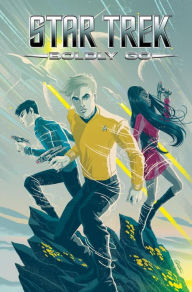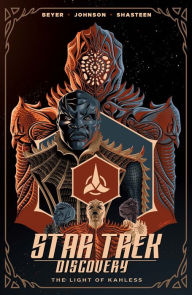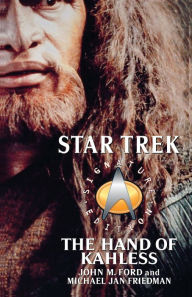Plotting Discovery’s Course Through Star Trek History
Star Trek: Discovery: Desperate Hours
Star Trek: Discovery: Desperate Hours
By David Mack
In Stock Online
Paperback $16.00
After an impossibly long build-up, Star Trek Discovery premiered last night with the two-part episode “The Vulcan Hello/Battle at the Binary Stars.” Discovery takes place about a decade before the original series, and focuses on Michael Burnham (Sonequa Martin-Green), first officer of the USS Shenzou under Captain Philippa Georgiou (Michelle Yeoh). There’s an easy camaraderie between the two women, born of seven years serving together. It’s a friendship that will be sorely tested before long: the ship is dispatched to investigate a damaged probe on the far edges of Federation space when they encounter a mysterious artifact that might be responsible. Upon investigation, Burnham discovers that the object is both ancient—and Klingon. Accidentally activating it, she sets in motion a plan by a Klingon warlord named T’Kuvma to unite the 24 disparate houses of the Empire into a cohesive force under his banner. This is not good news for the crew of the Shenzou.
Even though she’s not the Captain, Burnham is the main character, and she’s genuinely, as the Vulcans would say, fascinating. We learn that, following an incident with the Klingons that left her an orphan, she was raised on Vulcan under the tutelage of Sarek, aka Spock’s dad. (Yes, this makes her the second secret sibling of our favorite science officer, after Star Trek V’s Sybok, but the less about him, the better.) Though fully human, her training in science and Vulcan philosophy gives her incredible advantages as an officer. It also brings conflict, which the writers wisely bring to the fore. Treasonous actions near the conclusion of the premiere could be interpreted as wildly emotional, or coldly logical. We’re not given a clear-cut interpretation, and even Burnham herself isn’t sure.
Even though we were promised a continuing story, the degree to which the events of the episode have upended the table is genuinely surprising for this franchise. Earlier series (mostly Deep Space Nine) toyed with serialization, but only intermittently. Discovery is rolling out the story in a very modern way. The typical formula for Trek has been to establish the status quo in episode one, and more or less stick with it for however many seasons that Nielsen grants. This go-round, the first TV Trek since Enterprise ended a dozen years ago, is more interested in the ongoing story of Michael Burnham, and by the end of the second episode, it’s clear that we’ll wind up following her to interesting places.
After an impossibly long build-up, Star Trek Discovery premiered last night with the two-part episode “The Vulcan Hello/Battle at the Binary Stars.” Discovery takes place about a decade before the original series, and focuses on Michael Burnham (Sonequa Martin-Green), first officer of the USS Shenzou under Captain Philippa Georgiou (Michelle Yeoh). There’s an easy camaraderie between the two women, born of seven years serving together. It’s a friendship that will be sorely tested before long: the ship is dispatched to investigate a damaged probe on the far edges of Federation space when they encounter a mysterious artifact that might be responsible. Upon investigation, Burnham discovers that the object is both ancient—and Klingon. Accidentally activating it, she sets in motion a plan by a Klingon warlord named T’Kuvma to unite the 24 disparate houses of the Empire into a cohesive force under his banner. This is not good news for the crew of the Shenzou.
Even though she’s not the Captain, Burnham is the main character, and she’s genuinely, as the Vulcans would say, fascinating. We learn that, following an incident with the Klingons that left her an orphan, she was raised on Vulcan under the tutelage of Sarek, aka Spock’s dad. (Yes, this makes her the second secret sibling of our favorite science officer, after Star Trek V’s Sybok, but the less about him, the better.) Though fully human, her training in science and Vulcan philosophy gives her incredible advantages as an officer. It also brings conflict, which the writers wisely bring to the fore. Treasonous actions near the conclusion of the premiere could be interpreted as wildly emotional, or coldly logical. We’re not given a clear-cut interpretation, and even Burnham herself isn’t sure.
Even though we were promised a continuing story, the degree to which the events of the episode have upended the table is genuinely surprising for this franchise. Earlier series (mostly Deep Space Nine) toyed with serialization, but only intermittently. Discovery is rolling out the story in a very modern way. The typical formula for Trek has been to establish the status quo in episode one, and more or less stick with it for however many seasons that Nielsen grants. This go-round, the first TV Trek since Enterprise ended a dozen years ago, is more interested in the ongoing story of Michael Burnham, and by the end of the second episode, it’s clear that we’ll wind up following her to interesting places.
Star Trek: Boldly Go, Vol. 1
Star Trek: Boldly Go, Vol. 1
By
Mike Johnson
Illustrator
Tony Shasteen
Paperback $19.99
There are interesting connections to literary sources too: unlike Star Wars, where everything in the novels and comics is canon (until it isn’t), Star Trek’s policy has generally been that it happened onscreen, or it never happened. Depending on the type of fan you are, it’s either incredibly cool or deeply frustrating that there are almost as many Star Trek continuities as there are Star Trek books and comics. That’s changed recently, even if unofficially: the comic book and graphic novel series from IDW based on the Kelvin/Abrams-verse movies has maintained a fairly tight continuity, filling in the gaps between the films, and even getting referenced by them in turn—take the new Boldly Go series, which continues the story past Star Trek Beyond, and might wind up being the last word on that journey, given the question marks around a potential fourth film.
Likewise, there are two books on the way that tie in to Discovery closely enough that they can probably be considered canon. Desperate Hours, by Trek-novel superstar David Mack, is a prequel to the prequel. While the show sees Michael Burnham as a seasoned first officer, the book finds her at the beginning of that particular job. Newly promoted to acting first officer, she’s forced to prove herself by infiltrating an ancient alien vessel that’s attacking a Federation colony world. Onscreen, Burnham is one of the most interesting Trek protagonists in some time, but we get to know her on the run, in a sense—at a crisis point in her career and in the history of the Federation. The book allows us to spend a bit more time with her before everything blows up.
There are interesting connections to literary sources too: unlike Star Wars, where everything in the novels and comics is canon (until it isn’t), Star Trek’s policy has generally been that it happened onscreen, or it never happened. Depending on the type of fan you are, it’s either incredibly cool or deeply frustrating that there are almost as many Star Trek continuities as there are Star Trek books and comics. That’s changed recently, even if unofficially: the comic book and graphic novel series from IDW based on the Kelvin/Abrams-verse movies has maintained a fairly tight continuity, filling in the gaps between the films, and even getting referenced by them in turn—take the new Boldly Go series, which continues the story past Star Trek Beyond, and might wind up being the last word on that journey, given the question marks around a potential fourth film.
Likewise, there are two books on the way that tie in to Discovery closely enough that they can probably be considered canon. Desperate Hours, by Trek-novel superstar David Mack, is a prequel to the prequel. While the show sees Michael Burnham as a seasoned first officer, the book finds her at the beginning of that particular job. Newly promoted to acting first officer, she’s forced to prove herself by infiltrating an ancient alien vessel that’s attacking a Federation colony world. Onscreen, Burnham is one of the most interesting Trek protagonists in some time, but we get to know her on the run, in a sense—at a crisis point in her career and in the history of the Federation. The book allows us to spend a bit more time with her before everything blows up.
Star Trek: Discovery - The Light of Kahless
Star Trek: Discovery - The Light of Kahless
By
Mike Johnson
,
Kirsten Beyer
Illustrator
Tony Shasteen
Paperback $15.99
Similarly, IDW is beginning a new comic book series, to be collected next year. The Klingon leader T’Kuvma, though clearly the antagonist of these first couple of episodes and a real threat to our friends on the Shenzou, is nonetheless a compelling figure in his own right. He’s on a genuine spiritual quest, and believes deeply that the conformity represented by the Federation is an existential threat as great as any military conquest. The book is by long-time Trek comics writer Mike Johnson, show writer Kirsten Beyer, and artist Tony Shasteen, and focuses on T’Kuvma and his Klingon cult as a lead-in to the series. )Beyer, by the way, came to the TV show by way of a career writing Star Trek novels. Since she began it in 2008, her Voyager: Full Circle series has become at least as well loved—if not more—than the series on which it’s based.)
Similarly, IDW is beginning a new comic book series, to be collected next year. The Klingon leader T’Kuvma, though clearly the antagonist of these first couple of episodes and a real threat to our friends on the Shenzou, is nonetheless a compelling figure in his own right. He’s on a genuine spiritual quest, and believes deeply that the conformity represented by the Federation is an existential threat as great as any military conquest. The book is by long-time Trek comics writer Mike Johnson, show writer Kirsten Beyer, and artist Tony Shasteen, and focuses on T’Kuvma and his Klingon cult as a lead-in to the series. )Beyer, by the way, came to the TV show by way of a career writing Star Trek novels. Since she began it in 2008, her Voyager: Full Circle series has become at least as well loved—if not more—than the series on which it’s based.)
Star Trek: Signature Edition: The Hand of Kahless
Star Trek: Signature Edition: The Hand of Kahless
By John M. Ford , Michael Jan Friedman
In Stock Online
Paperback $23.95
The producers have acknowledged their debt to one novel in particular: John M. Ford’s The Final Reflection (along with its conceptual sequel, 1987’s How Much for Just the Planet). Ford’s 1984 novel is credited with building a compelling Klingon culture before we’d seen one onscreen. Though fan-favorite villains from the beginning, the Klingons of the original series were mostly weasels in dark makeup. By the time of The Next Generation, Ford’s idea of the Klingons as a people deeply invested in honor and martial glory seemed to have stuck. And even in the first two episodes of Discovery, homage is paid to Ford’s book: T’Kuvma and company talk about the Black Fleet, a form of the Klingon afterlife Ford innovated. That the leadership of the Klingon Empire is made up 24 divided houses is likewise an idea from Ford. There are more subtle hints, as well: the book’s lead is a Klingon without a house who comes to found his own dynasty, not unlike the show’s albino Voq, who becomes T’Kuvma’s right hand, despite his outcast status.
There are other callbacks too particularly to the original series, but Discovery works surprisingly well even if you’re not a huge Trek fan. Given the mixed reception the last Trek series (also a prequel) received, it’s not unreasonable to question the decision to set the show pre-Kirk. The look isn’t quite right if that’s a primary concern: it works incredibly well as a futuristic sci-fi series, but it’s hard to place it visually alongside the Enterprise of Kirk and Spock. Maybe that will change, but it’s also hard to care when the show is this engaging.
What did you think of Discovery‘s maiden voyage?
The producers have acknowledged their debt to one novel in particular: John M. Ford’s The Final Reflection (along with its conceptual sequel, 1987’s How Much for Just the Planet). Ford’s 1984 novel is credited with building a compelling Klingon culture before we’d seen one onscreen. Though fan-favorite villains from the beginning, the Klingons of the original series were mostly weasels in dark makeup. By the time of The Next Generation, Ford’s idea of the Klingons as a people deeply invested in honor and martial glory seemed to have stuck. And even in the first two episodes of Discovery, homage is paid to Ford’s book: T’Kuvma and company talk about the Black Fleet, a form of the Klingon afterlife Ford innovated. That the leadership of the Klingon Empire is made up 24 divided houses is likewise an idea from Ford. There are more subtle hints, as well: the book’s lead is a Klingon without a house who comes to found his own dynasty, not unlike the show’s albino Voq, who becomes T’Kuvma’s right hand, despite his outcast status.
There are other callbacks too particularly to the original series, but Discovery works surprisingly well even if you’re not a huge Trek fan. Given the mixed reception the last Trek series (also a prequel) received, it’s not unreasonable to question the decision to set the show pre-Kirk. The look isn’t quite right if that’s a primary concern: it works incredibly well as a futuristic sci-fi series, but it’s hard to place it visually alongside the Enterprise of Kirk and Spock. Maybe that will change, but it’s also hard to care when the show is this engaging.
What did you think of Discovery‘s maiden voyage?



